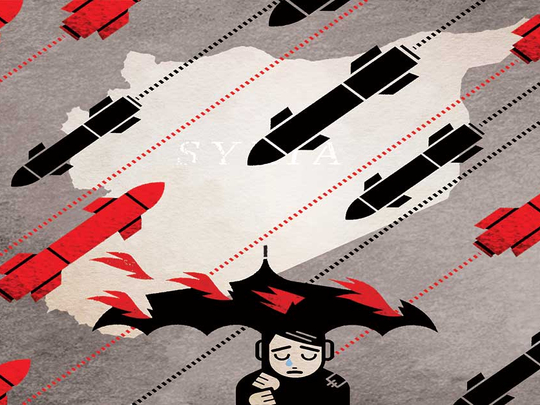
Back to Syria again, where you thought the war was winding down, soon to be brought to a close, with the regime having its day and the rebels their eclipse. But what about those horrendous images, delivered to our living rooms last week courtesy the BBC, of the chlorine attack on East Ghouta, the rebel-held suburb of Damascus, whose 400,000 inhabitants have been under siege since 2013 by Russian-backed government forces and effectively told, “Surrender or starve”? The images were real, of course, but we balked at accepting their realness.
In her iconic 2003 book, Regarding the Pain of Others (the last she wrote before her death the following year), Susan Sontag, one of the most influential social critics of her generation, who wrote about and travelled to areas of conflict, including the Vietnam War, the first intifada in Palestine and the siege of Sarajevo, addressed the issue of war photography that depicts images of unspeakable suffering and wanton atrocity.
Sontag posited the notion that though frames confer meaning on images, those who have not themselves lived those images cannot discern what they truly represent. Moreover, something within us flinches at the horror, at the principle that “if it bleeds, it leads”. So consequently, we turn away, if unconsciously, in nauseated disbelief — and move on with our lives.
Those of us, for example, who watched the sarin attack on East Ghouta, that took place in the early hours of August 21, 2013, and saw children writhing in pain, and adults going through convulsions as they foamed at the mouth, or saw the image — one that shocked the world — of Omran Daqneesh, the five-year-old boy in Aleppo in August 2016, being pulled out from under the rubble, following an air strike by government forces, caked with dust and with blood on his face, convinced ourselves that what we were looking at surely must be unreal. Surely it is all playing out not in real life but on the silver screen.
Last week, the horror — all too real, trust me on this one — came back to confront us again, and to haunt the inward preoccupations of our human selves: The besieged people of Ghouta were again under attack by poison gas, by barrel bombs from the air, by hell fire from the ground, by being there from a trick of fate. And again the images made us avoid the overload to our psychic being. Who, after all, wants to contend with the fact that more than 180 people were killed there in a little over two weeks?
But there are peace talks, you say, brokered by the United Nations, going on in Geneva between rebel groups and the Syrian regime, pursuant to Security Council Resolution 2254. Yes, the end to the suffering must be at hand.
The fact — the killing of civilians in Syria has become so routine that it is now banal — is that the Syrian regime, backed by its military forces, the muscle of Russian air power and sundry militias from Iran, Lebanon and Iraq, is on a murderous pursuit, conquering those who, since March 2011, have dared question its reliance on coercion, terror and violence to rule over its citizens. The talks, in fact, are a fig leaf. (The two sides don’t even sit in the same room to negotiate.)
In December, following a series of “ceasefires” aimed at winding down the war and preparing for a peace deal, the regime, backed by Russian air support, actually launched new offensives in the so-called “de-escalation zones”, mostly in Ghouta, but also in the northern province of Idlib — offensives that included deliberate assaults on civilian targets, resulting in the exodus of more than 100,00 Idlibians north towards the Turkish border.
The fractious opposition groups, encouraged by US Secretary of State Rex Tillerson’s statement earlier that “We are confident that the fulfilment of these talks will produce a Syria that is free of Bashar Al Assad and his family”, arrived in Geneva after issuing a communique that said the Syrian president had to give up power at the start of any political transition. The talks, if talks they were, fizzled out, with the chief UN negotiator, Staffan de Mistura, saying the Syrian government was not “really looking to find a way to have a dialogue”.
So why doesn’t the United Nations implement its own principle of “Responsibility to Protect” in Syria, a doctrine that allows the international body to intervene in order to protect civilians from being slaughtered or in any way brutalised, as they are in Syria? The impressive ease with which the killing of men, women and children in that country has gone on over the last seven years bedevils the mind, yet “Responsibility to Protect” was never invoked. Thus the Syrian regime is effectively given a free hand to starve, devastate and crush Ghouta.
In December 2016, after a four-year siege — one of the longest in modern warfare, where cluster bombs, chlorine, bunker-busters and crude barrel bombs were dropped on neighbourhoods and market places — Aleppo fell to government forces. It had always been Al Assad’s wish to see the city, once the most populous and reportedly the oldest continuously inhabited in the world, turned into a pile of rubble. Well, Al Assad’s wish has been granted. Now he wants to inflict the same fate on Ghouta.
Damn the man.
Fawaz Turki is a journalist, lecturer and author based in Washington. He is the author of The Disinherited: Journal of a Palestinian Exile.










